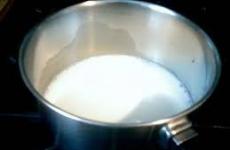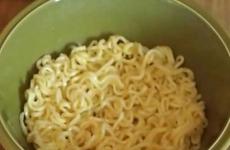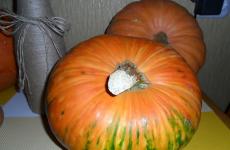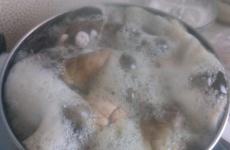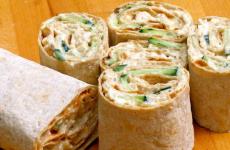Which cutting board is best: Buyer's guide. Cutting boards: which are better, features of choice and recommendations Plastic cutting board
Any cuisine. Housewives use it daily for slicing, chopping and cooking various dishes. And if you are planning to buy a new one, then you should know which cutting board is better, what factors should be considered when choosing a cutting board.
The first thing you should pay attention to when choosing is what the cutting board is made of. For the manufacture of kitchen boards use a lot various materials: wood, plastic, glass and even stone.
wooden boards

Even our grandmothers and great-grandmothers used wooden cutting boards. And in our time wooden planks preferred not only by simple housewives, but also by professional chefs.
The quality of a wooden board directly depends on the type of wood from which it is made. Hevea boards are considered the best. They are durable, withstand heavy loads, do not swell from moisture.
Wooden boards are also good because small scratches and cuts can be restored. The tree has bactericidal properties, which is important for kitchen hygiene. When using a wooden board, kitchen knives do not get dull.
But often in stores you can find boards made of soft wood that easily crumble, absorb water and odors. Such boards are best used for cutting bread.
Bamboo boards

Bamboo boards cannot be attributed to wooden ones, because bamboo - herbaceous plant. But, despite this, they are superior in quality to some wooden ones, they are durable, absorb moisture and odors a little.
But in the manufacture of bamboo boards, an adhesive is used that may contain formaldehyde. Therefore, when buying a bamboo board, it is important to make sure that a safe glue is used.
Plastic (plastic) boards 
Plastic boards are good because they are available in various sizes, colors and shapes. If you buy a quality board, you can expect it to be beautiful, durable, water resistant and hygienic. But more often in stores there are boards made of low quality plastic, which, in best case, quickly lose their presentation and become unusable, and at worst, they can be harmful to health due to harmful impurities that make up the plastic.
glass boards 
Recently, glass cutting boards. Such a board has a lot of advantages - strength, hygiene, resistance to moisture and high temperatures. In addition, they are amazingly beautiful. But in the kitchen of many housewives, they have taken root only as a decoration or a hot stand. The fact is that many people cannot bear the sound made by a knife when cutting on such a board. And another significant drawback - the knives become dull very quickly.
Silicone cutting boards 
These products are called boards conditionally, rather they are cutting mats. They are practical, hygienic, have various design. When stored, they practically do not take up space, since they can even be rolled up into a tube. But it is somewhat inconvenient to use such rugs if you need to bring chopped food to the pan on the board itself. A trifle, but still ...
stone boards 
They are made from marble or granite. Such boards are certainly beautiful and hygienic. But they are very heavy, afraid high temperatures and acids, require additional care. Due to the hardness of the material, the knives become dull quickly.
Nowadays, in the mode of increased competition, manufacturers began to improve even such simple things as cutting boards. 
There is a board combined with scales. I cut the product and immediately weighed it. 
The sieve board allows you to wash food directly in the cutting board. 
Boards can be equipped with an additional box or containers for husks or cleanings. 
Cutting boards can be folded for easy storage or for carrying food. 
Very practical boards that are installed on the sink. 
There are special boards for bread, in which the crumbs are collected in a special compartment.
- Any thing, if properly cared for, will last a long time. There are several rules for cutting boards.
- Wooden boards must be washed only by hand, do not leave them in water for a long time. Wipe clean after washing and let dry. Drying out is also harmful for them, because. cracks may appear.
- Plastic boards can be washed in dishwasher.
- Do not place hot objects on stone boards and do not use acid products in the care.
- If you need to get rid of the stubborn smell, then the boards (except stone) can be wiped lemon juice or acetic acid and then rinse with water detergent.
Now feel free to go to the store for a new thing for yours. You know which cutting board is better, all the advantages and disadvantages of any kitchen board.
And be sure to watch the video. It tells you how to properly care for your end cutting board. Informative.
When purchasing kitchen utensils, all the nuances and moments should be taken into account so that cooking is safe, comfortable and pleasing to the eye. Today we will talk about cutting boards, their strengths and weaknesses.
Of course, such strict sanitary standards are followed mainly by enterprises. Catering, at home such a number is useless. Five boards will be enough for your home and your family to work with different products.
To work with raw meat;
To work with fish;
To work with finished products;
For working with vegetables;
For bread.
Perhaps someone will have a question - why are there so many boards in the kitchen, if you can get by with one or two? The fact is that when cutting meat, fish and vegetables on the same board, tastes and smells will be mixed - this will not affect the final taste of the dish very well.
Also, raw meat contains different kind bacteria that live and multiply in meat before heat treatment is beneficial for the human body, they will not affect ... Accordingly, working with fresh vegetables after cutting meat, infection with these bacteria and fresh vegetables is inevitable, which after, we will safely eat in a salad.
Of course, if you wash the board well after working with meat, fish, there will be no trace of bacteria. But this is not entirely true, the temperature must be very high to cope with them, just the smell, right away, will not go anywhere. By the way, this also applies to knives - therefore, it is not in vain that you should buy knives in the same way, at least five pieces, for a different product group.
Size and shape matter
The shape of the cutting board is chosen for a certain type of product, and also, convenience is not an unimportant aspect. Rectangular - is considered the most popular and convenient. In addition to rectangular, there are more other shapes - round, square, oval and various shapes of fruits, vegetables, etc.
If you are going to buy a board for cutting meat, fish, which involves working with bones, choose the appropriate thickness and size.
Types of cutting boards - pros and cons
To begin with, it is worth saying that there are boards made of plastic, glass, bamboo and wood - solid, end and ordinary species.
Wooden boards - regular- wood bars are also made, where the fibers are located horizontally. Material - linden, pine, beech, oak, hevea (soft and hard varieties).



|
pros |
Minuses |
|
Non slip base. Knives don't get dull. Durable enough with proper care durable Resistant to damage and temperature changes Excellent resistance to stress (cutting meat) Eco-friendly, antibacterial, natural material - bacteria do not multiply, getting into the fibers of the tree, they die. Particles of wood entering the body do no harm. |
Colored with fruits and vegetables. They swell and bloom from increased moisture. Weight, depending on size and thickness. Do not wash in the dishwasher and chemical. means. Keep odors on the surface for a long time. |
Whole planks of wood- made from solid timber, only hardwood, the fibers are arranged horizontally.



The pros and cons of these boards are the same as those of ordinary boards, it is only worth adding that they are much more expensive, handmade and differ total absence glue.
Wooden boards - end, are made, like ordinary beams, only the fibers are arranged vertically.



Advantages and disadvantages, as in the usual. The following is worth adding - these boards retain their aesthetic appearance, much less blunt knives. Above and antibacterial properties. The disadvantages include the fact that they require additional care - by lubricating the board with oil.
Bamboo cutting board. The mistake is that they are attributed to a tree - this is not correct, because bamboo is a grass! In appearance, yes - it is indistinguishable from a tree.



A bamboo board is made as follows - the bamboo is dried, finely chopped and glued with epoxy glue.
plastic board



|
pros |
Minuses |
|
Lungs. It is convenient to pour out chopped products. They do not retain odors. Strong enough. Affordable price. Greater variety of colors and shapes. |
Scratches quickly appear on the surface. They do not have antibacterial properties, even with this coating - this is a delusion. Not eco-friendly material - plastic, there is plastic. Not temperature resistant. May have a slippery base or surface. |
glass board and ceramic



|
pros |
Minuses |
|
Beautiful appearance that lasts for a long time. They do not retain odors. Can be washed in a dishwasher. Due to the smooth surface - antibacterial. Temperature resistant. Beautiful drawings, bright design. |
Slippery surface. Blunts knives. Makes an unpleasant sound when the board and knife come into contact. Fragile material. When cracks appear, they are not suitable for further use, since there is a danger of glass with food entering the human body, and this is inevitable damage to internal organs. Not intended for cutting meat. |
Silicone mat


Board with handles - easy to move.
Don't forget about the hole in the board for wall mounting.
Boards with recesses, convenient in that the secreted juice from the products is collected there.
For storage and drying, a board stand is desirable.
Take proper care of cutting boards so that they serve faithfully long years.
The main criteria for choosing a cutting board are ease of use, maintenance, and hygiene. Therefore, first of all, pay attention to the size of the product, and the material from which it is made.
The optimal size and shape of the cutting board
When it comes to size and shape, it's hard to give universal advice. The most convenient shape of the cutting board is rectangular, 5-10 mm thick. However, modern cutting boards come in a wide variety of shapes. For everyday slicing of bread, sausage and cheese, a board is suitable small size. However, cutting meat, fish, shredding cabbage, rolling out dough on such a board is inconvenient. At the same time, washing in small sinks and drying bulky boards also does not add comfort.

Beyond convenience this advice relevant when it comes to hygiene. Therefore, experts also recommend having separate cutting boards for meat, fish, vegetables, fruits and bread. Especially if you are a supporter of environmentally friendly materials, and prefer products from natural wood absorbing odors. It is good if the cutting boards are visually different in shape and material of manufacture, so as not to accidentally confuse.
Looking after the board - estimate the place of its storage. If your kitchen is equipped with special hooks, then choose boards with eyelets (to make it convenient to hang).
Well, you can store cutting boards on special stands: convenient, and the design takes up little space.

Types of materials for cutting boards, their pros and cons
Natural wood cutting boards
Wooden cutting boards on today the most familiar and popular. The very appearance of a natural warm tree and the natural pattern of its trunk adds coziness and warmth to this product. If you decide to stay on a wooden board, then ask the seller what kind of wood the product is made of. Naturally, the tree needs to be chosen stronger. Oak, linden, olive, cedar - these are durable woods for a cutting board. And cedar and olive, in addition to strength, also have bactericidal properties.

Often wooden boards are made from birch and pine. Please note that such boards will quickly lose their original appearance, as scratches and knife marks easily appear on “soft” rocks.
AT recent times bamboo boards are popular. They are comfortable, practical, do not dry out and do not blunt knives.
Separately, it is worth mentioning cutting boards made of hevea (rubber tree). Such products are durable, poorly absorb moisture, and pleasant to the eye.
Wooden boards are made from a single piece of wood and glued from several slats. It's hard to say which one is better. Both of them can serve faithfully for more than one year. But sometimes solid wood boards bend, and slatted boards stick out. And it all depends on the quality of the product - here it’s how lucky.

Advantages of wooden boards:
- environmentally friendly material;
- organically look in the kitchen made of natural wood;
- Can be used as a hot plate.
Cons of wooden boards:
- dry out;
- leave traces of cutting objects;
- absorb odors
- are considered unhygienic: cracks clog food particles;
- require careful maintenance.
How to care for wood planks

Wooden boards need careful maintenance. After using the cutting board for meat and fish, wash it with a sponge and brush with detergent, rinse with water and dry. To maintain hygiene, wooden boards are recommended to be regularly doused with boiling water.
For elimination bad smell the board should be wiped with a slice of lemon or acidified water with vinegar.
Plywood cutting boards
Plywood cutting boards are made up of several glued layers of veneer. A plywood board is a budget option for a wooden board. Plywood does not bend, does not warp. It is strong and durable. However, provided that the material is of excellent quality, certified and, therefore, safe. Some craftsmen make such boards at home, giving them funny shapes. However, opponents of plywood as a cutting board use believe that the formaldehyde resins with which plywood is glued can get into food, and this is unhealthy.

Advantages of plywood board:
- low price, availability.
- lightness.
Minuses:
- the top layer of plywood wears out quite quickly under a knife blade;
— insecurity due to the presence of adhesive components.
Plastic cutting boards
Plastic boards are less popular than wooden boards. However, they have their adherents who consider plastic to be more hygienic than wood. Some plastic cutting boards have a special antibacterial coating and are therefore ideal for cutting meat and fish.

However, when purchasing a plastic board, pay attention to the quality of the material. Shortly after cutting the products, marks and scratches from knives will appear on low-quality plastic, and the color of the material may fade and lose its original appearance.
Advantages of plastic boards:
- plastic is not subject to deformation (unlike wood) and is well washed;
— plastic boards can be washed in the dishwasher;
- plastic does not dull knives (when compared with glass or ceramics);
- thanks to the flexible material, it is from plastic that transforming boards are made that change shape (and this is additional comfort during cooking).

Cons of plastic boards:
- quite quickly, plastic boards become unsightly, become scratched and rough;
- many do not like to cut food on plastic, considering it not environmentally friendly;
- plastic can not be used as a stand for hot.
Glass cutting boards
Glass boards are popular for their beautiful design and durability. Often they are very picturesque, therefore they simultaneously serve for cutting products and as an independent kitchen decor. Glass is easy to clean and does not absorb odors. However, glass also has disadvantages.

Advantages of glass boards:
- strength and smoothness, as the knife does not leave marks;
— durability;
- ease of care;
- hygiene.
Cons of glass boards:
- high price (compared to wooden and plastic ones);
- fragility;
- glass boards are heavy;
- when cutting products, the blade of the knife, in contact with the glass, makes unpleasant sounds;
- Knives dull faster on glass.

stone boards they are usually made of marble, and they have the same advantages and disadvantages as glass ones. They also have similar characteristics ceramic boards.
Combined cutting boards
Not so long ago there were products that combine plastic and wood. So, one plastic side with beautiful pattern and antibacterial coating can be used for cutting products with specific odors (meat, fish). Or serve as a serving area. And another surface made of bamboo wood is suitable for cutting bread. Such a universal option, 2 in 1, will last for many years and will be in harmony with the interior of any kitchen.
Wooden cutting board is the perfect choice for the kitchen
A kitchen board is an indispensable attribute of any kitchen, without which no self-respecting cook can do. Modern manufacturers offer a wide range of cutting boards made of various materials and having different configurations. Boards can even be built-in and move along the edge of the sink. Everything possible is done so that the cooking process causes only positive emotions. Despite the huge variety of materials, wooden cutting boards remain the most popular, safe and convenient.
Why is wood the best material?
Wood has always been considered the best natural material for production. kitchen utensils. What is the reason for such popularity? First of all, wood products are distinguished by a special lively warmth, giving positive energy and beneficial to human health.
Products from natural materials environmentally friendly and do not emit harmful substances, which is very important for the preparation of quality food. Some varieties of trees have an antibacterial effect. Bacteria and fungi do not multiply on cutting boards made from such wood.
Wooden cutting boards serve as a wonderful decoration for the interior of the kitchen and create a cozy atmosphere. decorative look such products are given a painting or a new type of decoration - decoupage. You can buy beautiful decorative wooden boards for a gift.

What wood is used to make kitchen boards?
There are more than a thousand species of trees growing on the planet. The wood of many of them is used by a person for personal purposes. Each tree has its own properties and is used for specific purposes. What breeds are used to make cutting boards?
Pine
- inexpensive, but rather soft material with a healing effect. Phytoncides secreted by pine wood kill microbes and have a beneficial effect on human organs. Selection useful substances does not stop even after processing pine. The disadvantage of this lumber is its fragility.Larch
- a valuable and durable material, resistant to dampness and reproduction of various putrefactive fungi. Beautiful colour and good structure makes larch one of the best materials for making wood cutting boards.Beech
- solid wood, different pink and unusual pattern. However, beech also has a disadvantage - it absorbs moisture well. That is why beech products are varnished. Cutting boards made from this lumber are used only for cutting dry products.Oak
- the strongest and most durable material. Oak kitchen board is not afraid of moisture and will serve for a long time. During operation, the wood does not emit harmful substances, does not lose its attractive appearance and cracks and does not dry out.Nut
- moderately hard material that is easy to process and has a smooth and coarse texture. Kitchen boards made of walnut are not afraid of moisture and have high wear resistance.Ash
- a material that is not inferior in strength to oak, but has its own characteristics: expressive texture, moisture resistance, resistance to deformation.Cherry
- beautiful material, which has a high density, which in its decorative qualities outperforms all lumber used to make kitchen boards.

Regardless of the type of wood, everything perfectly absorbs odors, so it is recommended to have several boards: for meat, fish, bread and vegetables. It is recommended to purchase a set of cutting boards and use each element strictly for its intended purpose.
A few secrets of choosing a cutting board made of wood
There are several secrets that will help to make right choice. First of all, when buying such a kitchen attribute, you need to carefully look at its appearance. This will allow us to draw some conclusions. So, cutting boards made of natural solid wood have a solid wood pattern.
Kitchen boards made from narrow strips - plots - gained wide popularity. Such products will last much longer in the kitchen than solid wood boards with proper care. They cannot be left in a humid environment for a long time, which can lead to delamination and the ingress of wood particles into food.
Professional chefs in most cases use the so-called end cutting boards, in which the fibers are not parallel to the cutting surface, but perpendicular to it. This surface is more durable and strong. Knives when using the end board require less frequent sharpening, which is very important for cooks who prepare dishes throughout the day.

Olive oil is the best material for impregnating kitchen boards
Cutting boards should be impregnated to extend their lifespan. vegetable oils. Olive oil - the best option for impregnation, the use of which will lead to the achievement of the following goals:
- the appearance of the kitchen board does not deteriorate;
- no harm to health;
- increases the service life of the product.

At proper care wooden cutting boards will serve their owners for many years and will make the cooking process enjoyable.
If you have never bought a cutting board in your life, most likely someone in your family can handle wood very well, and a DIY kitchen board is not a problem for you. In the meantime, this is the belonging that a large number of time has changed the least.
Naturally, home boards are of various shapes, decorative and semi-decorative, with and without patterns.
Materials for making a kitchen board
- Wood:
- pine,
- Birch,
- acacia,
- bamboo,
- hevea.
- stone;
- plastic;
- glass ceramics;
- silicone.

Now let's take a quick look at all types of material.
Wood
Wood cutting boards are probably the most popular. Often, in stores you can find beech or pine, but they absorb moisture very much, crumble, and food residues accumulate in chips and slots. Therefore, pine and beech boards are preferably used for cutting bread and dry foods.
Bamboo and hevea are considered to be impeccable materials:
- they have high strength;
- do not swell in water and do not absorb moisture;
- wash well;
- do not blunt knives;
- do not absorb odors.
Such boards are the preference of professionals! For natural, from hevea and bamboo, the price is quite high, and from oak and acacia - even higher, but you can overpay for the quality.

Hint: if you want to choose good board, pay attention to its lateral surface. On a solid board, the drawing should be clearly visible. The greater the width, the greater should be the thickness so that it does not deform from moisture.
Stone
Cutting boards made of stone, marble or granite look very beautiful. And besides, marble has bactericidal properties. A stone board is useful for working with dough, it comes out thin, even and cool.
When buying it, remember that the stone is a breathable material. Such products must be constantly cleaned and polished.
It is not necessary to put hotter on marble, it also does not like acids. Well, if you work a lot with dough, then, accordingly, a marble kitchen board in your kitchen will be simply irreplaceable.

Such accessories are durable and, with proper care, can last for decades.
Plastic
Quality plastic:
- heat resistant
- hygienic,
- durable,
- moisture resistant.
In addition, plastic allows the manufacturer to fantasize with:
- form,
- color,
- design
But all these definitions apply to qualitative things. Cheap plastic quickly gets dirty, scratched and loses its appeal.
Note! When buying kitchen cutting boards made of plastic, focus on their color: bright dyes are very likely to contain toxic substances.
But remember that you can’t cut meat, bread and vegetables on the same board! I am sure that after reading this article you will optimal choice, and the attached video visualizes the information received.

